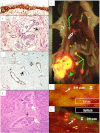Clinical and biological implications of the tumor microenvironment
- PMID: 22782446
- PMCID: PMC3399064
- DOI: 10.1007/s12307-012-0099-6
Clinical and biological implications of the tumor microenvironment
Erratum in
- Cancer Microenviron. 2012 Aug;5(2):113
Abstract
In normal tissues and organs, the activities of the constituent cells are strictly restricted to the tasks assigned to them during development. In addition they (with the exception of leukocytes) remain inflexibly confined to their territorial domains by regulatory interactions with their neighbors.This creates specialized local micro-environments in which structure and function are orderly, stable and tightly controlled by feed-back loops, within interacting regulatory networks.This system has considerable ability to adapt to changing conditions. In contrast, the microenvironment in regions where tumors are forming and expanding is characterized by progressive loss of specialized or differentiated cellular functions,disorderly molecular signals, and degeneration of microscopical organ structure. This, coupled with the traffic of cells into and out of the tumor, often culminates in local invasion and metastasis to other organs. The nature of these disturbed molecular and cellular interactions is, by definition,highly unstable and increasingly unpredictable as time passes.It also varies between different tumors, sometimes even leading to regression. However, systematic analysis of this dysfunction in the tumor microcosm, using multiple modern research techniques, has revealed that all actively growing primary and secondary neoplasms share an absolute dependency upon support from adjacent non-neoplastic cells of the host. This support, in turn, continuously depends upon dynamic interplay between tumor and host cell populations, via signaling molecules and surface receptors in the tumor microenvironment.Such interplay determines the fate of the growing neoplasm. Such information, described and evaluated in this article, provides important new insights into the etiology of carcinogenesis and how tumor growth, invasion and metastasis might be therapeutically arrested. The facts and concepts assembled below, regarding the cancer microenvironment, demonstrate how modern molecular findings reveal the impact of the wide range of cancer diseases upon the internal cellular, tissue and organ environments of the whole individual and how this applies to designing new work to improve human cancer diagnosis and treatment. The article discusses several specific types of experimentally-induced and clinically common cancers to derive principles useful for interpreting events in the tumor microenvironment,which apply to cancers in general and especially to human malignant disease.
Figures



References
-
- Orr J. Changes antecedent to tumour formation during the treatment of mouse skin with carcinogenic hydrocarbons. J Pathol Bacteriol. 1938;46:495–515. doi: 10.1002/path.1700460310. - DOI
-
- Tarin D. Morphological studies on the mechanism of carcinogenesis. In: Tarin D, editor. Tissue interactions in carcinogenesis. London: Academic; 1972. pp. 227–289.
-
- Kratochwil K. Tissue interaction during embryonic development. In: Tarin D, editor. Tissue interactions in carcinogenesis. London: Academic; 1972. pp. 1–47.
LinkOut - more resources
Full Text Sources

